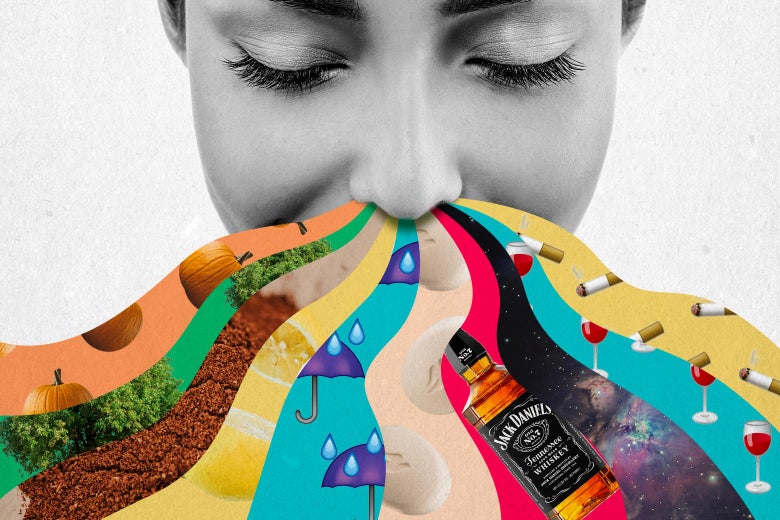Photo illustration by Slate. Photos by utkamandarinka/iStock/Getty Images Plus, Nathan Dumlao/Unsplash, Nicepear Jakarta/Unsplash, Akshay Bandre/Unsplash, Nathan Dumlao/Unsplash, angkhan/iStock/Getty Images Plus, Bryan Goff on Unsplash, and Apple.
Romance as a genre receives more than its fair share of mockery for, among other things, its overwrought olfactory descriptions. But one Twitter user has spent the past couple of years lovingly chronicling those very descriptions through the Male Scent Catalogue, which documents how authors describe male love interests and their odors:
Allison Breed, who runs the account, quit her job at the end of last year to spend 2020 traveling with her husband, only for the coronavirus to change their plans. Now Breed is filling the time in lockdown by reading at her home in Portland, Oregon, finding more fodder for the catalog in the process. Slate spoke to her about the Male Scent Catalogue and what it has taught her about the role of smell in romance. This interview has been condensed and edited for clarity.
Slate: You created this account in July 2018. What made you start keeping track of the male scents you read?
Allison Breed: That was the year I started recording everything that I read. I thought it’d be fun to pick out some things to keep track of in romance novels. I was highlighting female smells, male smells, tastes, the names for, like, a woman’s sex. But it was the male scents that stuck out to me.
Back up. When you say “names for a woman’s sex,” are you telling me you have a list of vaginal euphemisms somewhere?
I used to! I got rid of them because I had too many lists going. But I have them all highlighted. If I go back through the books that I read, I could find them. That year, 2018, I read, like, 420 books. That was when depression and a really boring job had their hold, and I was reading more than a book a day. I was reading a lot of good books as well as a lot of bad books, and the bad books always had the best ones. A lot of “pleasure buttons” and “happy buttons.” How is that sexy or appealing?
Why did you ultimately settle on smells for the Twitter account? And why male smells, in particular?
I was noticing what seemed like more variety in the way that women smelled until I started to break it down into groups, and then I realized that women just smell either like sweet-smelling flowers or strawberries or baked goods—something edible, something delectable, something decadent. That was boring to me. It is weird that so many protagonists know specific flowers. I’m reading one right now in which the woman apparently smells like carnations. I can’t for the life of me imagine what a carnation smells like. I can picture a carnation, but I can’t smell it.
Why do you think there are so many floral scents for women?
I think for the same reason that so few men smell like flowers, right? They smell strong, or they smell like the woods. It’s gendered. They’re not going to smell like some delicate little thing that doesn’t live long and is only there to be pretty. Men want to have substance. There are some crossovers. Women can smell like mint, and men smell like mint a lot. Citrus was a shared scent I noticed.
What smell trends have you noticed for men?
Woodsy, cedar, evergreen, pine. Spice and citrus seem to be mentioned together—although I read one today that specifically differentiated between spice and citrus. Sandalwood is common. Smelling clean and fresh, like soap—Irish Spring makes an appearance quite often. I know one author, Kate Clayborn, talks often about her love of Irish Spring.













